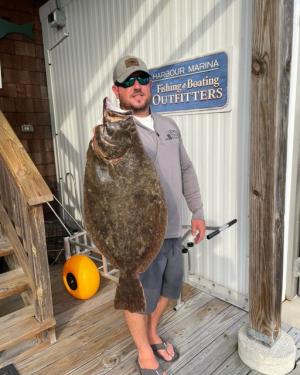Surf fishing has been pretty good all summer, primarily because the water temperature has stayed on the cool side, keeping spot, croaker and kings close to the beach. As fall approaches, the mullet will begin to leave the marshes and move down the coast, drawing larger predators close to shore and in range of those of us who fish from the beach. These will include big blues, trout, false albacore, flounder and perhaps bull red drum.
Back in the day when big blues were the kings of the surf, we would fish with Hopkins metal lures when we saw them tearing up schools of mullet. There are fewer big fish today, and finding them in large schools is unlikely. Fishing with a chunk of fresh bunker on a circle hook is a more productive setup in this day and age. Make sure when you put the bait on the hook that the barb is clear to do its job, not buried in the bait.
No doubt a live spot was the top bait for big trout, and there is no reason why it won’t work today. I had a cooler mounted on the front of my 1971 International Scout and a bilge pump hooked up to my battery. I could keep three dozen spot alive in there that I bought from Mrs. Murray for $10.
Today, a circle hook placed either up through the lips or through the eye sockets of the spot will do a good job of keeping the bait alive. A live spot also has the added benefit of attracting not only trout, but also red drum.
All of these circle hook baits should be run on fish-finder rigs. You can buy them already made at your favorite tackle shop or tie them yourself with 50- to 80-pound test mono line. Tie the line to the hook with a clinch knot. Run about 6 or 8 inches of line to a black swivel and tie it off. Your shock leader from the running line will pass through a fish-finder that holds the sinker. This ties to the black swivel with another clinch knot.
The idea is to let the trout or drum move off with the bait until the fish has it well in its mouth. Then come tight on the line and the circle hook will set in the corner of the mouth.
Another fish we used to catch on live spot was summer flounder. Most of these we caught by accident.
As we reeled a spot back in after a missed strike or to check the bait, we would get a hit close to or in the wash. This would always be a flounder, and they would always be good-sized fish.
False albacore, or little tuna, have constantly been a challenge for me from the beach. I can count on one hand the number I have caught from the sand, and I worked hard for every one.
The problem with false albacore is they don’t stand still. You have to cast where you think they are going to be; then they go and run somewhere else.
When you see a few birds hovering over the water, then a burst of bait and fish explode below, that’s false albacore. If you cast to the action, you will be way too late. What you have to do is try to figure out where they will pop up next.
Back when I was young and nimble, I would run up and down the beach chasing the birds and the fish, usually to no avail. As I aged and slowed, I got smart and let the birds and fish come to me.
My lure of choice for false albacore is the time-proven Hopkins. It will cast like a rocket and stay in the water during a fast retrieve. Remember to cast where you think where they will be, not where they are.
Now, while all these big fish are fun to catch, don’t forget about the little guys. Spot, croaker and kings will still be around into the fall.
Some of the biggest croaker I have ever caught from the beach have been in the fall. Broadkill Beach has been very good to me in September. Of course, I never go there on a west wind. They don’t make enough DEET to ward off all those flies.
Nothing fancy for croaker. Just a top-bottom rig baited with Fishbites bloodworm and cast out at various distances until I find where the fish are holding.
Kings are another good fall fish. Here too the largest of the season should be available. Same setup as with croakers, only the kings tend to be farther out from the beach.
























































